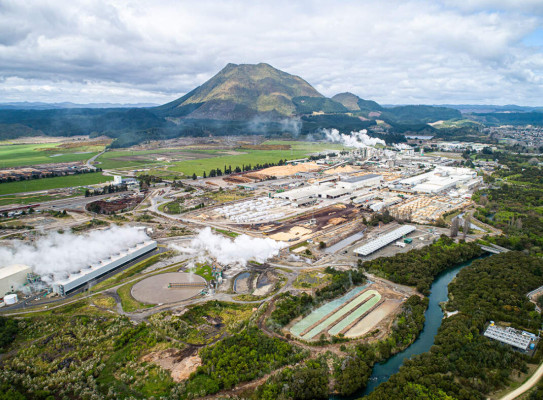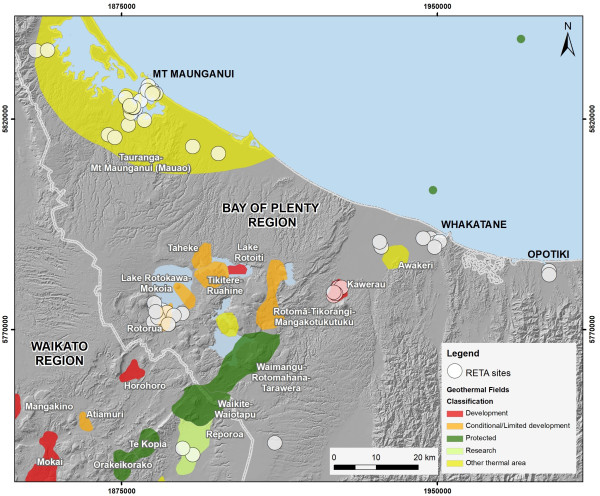Geothermal heat proves critical for Bay of Plenty's future

Bay of Plenty's big energy users can substantially reduce their greenhouse gas emissions...
...but they need to harness the region's high and low-temperature geothermal resources.
Looking local to decarbonise regions
New Zealand's Energy Efficiency and Conservation Authority (EECA) is working with regional big energy users to reduce carbon emissions and energy demands - and support their transition to using renewable sources of energy.
To support industries make this switch, EECA's Regional Energy Transition Accelerator (RETA) programme focuses on reducing the emissions of "process heat" – the heat used in manufacturing, warming spaces, and processing products.
-
Why focus on heat?
Process heat makes up one-third of New Zealand's overall energy use, with about 84% being used by our industrial and agricultural sectors. Commercial and public sectors use the rest, mainly for space heating in large buildings.
Across sectors, over half of New Zealand's total process heat is currently generated by burning fossil fuels. Every year, this is producing over 8 million tonnes of CO2 – approximately 8% of New Zealand’s total annual emissions.
Currently, coal and gas are considered the most economic fuels to produce process heat, mostly by using boiler systems. Two-thirds of process heat is used for low (less than 100°C) and medium (100-300°C) temperature requirements; the remaining third is used for high (>300°C) temperature requirements.
Low-carbon alternatives, like sustainable biomass fuels, electric heating, or tapping into geothermal heat, can replace the fossil fuels directly or the boiler systems entirely to reach these temperature requirements.
New report finds greater geothermal potential for Bay of Plenty
Published today, the Bay of Plenty Regional Energy Transition Accelerator (RETA) report, shows the role geothermal could play in reducing the region's reliance on fossil fuels.
The new report covers 28 of the region's large energy users. In total, they consume 14,741 TJ of energy, and produce 281 kt of CO2 per annum to generate process heat for a variety of needs.
The report identified most of these carbon emissions are from fossil gas. The good news is, across a range of case studies, EECA found these users can all make a switch to low-carbon alternatives – with geothermal having significant part to play.
Economically it makes sense for businesses with geothermal as an option [for energy] to seriously explore it.
Geothermal heat pumps could decarbonise the way we use heat
For EECA's Bay of Plenty RETA report, GNS Science provided a general overview of geothermal energy, technology and heat use in New Zealand, a summary of geothermal resources in the Bay of Plenty region, and an assessment of four sites in the region.
This is the first RETA report to consider geothermal energy as a solution to process heat.
GNS Geothermal Resource Management Specialist Brian Carey said "Bay of Plenty is richly endowed with geothermal, not only due to its high temperature systems, but also the widely available low and ambient temperatures."
In the assessment, GNS Scientists found that geothermal heat pumps (GSHPs) could efficiently meet the process heat needs - and reduce emissions - across a range of applications and locations. The case studies included analyses on feasibility of geothermal heat to supply Whakatāne hospital's heating, and Whakatāne Growers greenhouse production.
The report identified geothermal was the optimal fuel switch option using the marginal abatement cost analysis approach for the five applications / sites analysed .
For the process heat users we analysed, we found using geothermal heat energy significantly reduces their carbon emissions - by hundreds, to sometimes thousands, of tonnes of CO₂ per year.

-
How do geothermal heat pumps work?
Geothermal heat pumps, also commonly known as Ground Source Heat Pumps (GSHPs) harness the low temperature geothermal energy stored in soil, rock, surface water or groundwater and make this energy available for heating and cooling. Geothermal energy is any energy stored in or derived from the Earth; it is not limited to places with ‘hot ground’ like Rotorua or Taupō and is available across New Zealand. It is derived from three major sources: volcanic systems; stored energy from the sun; and energy radiated from the Earth’s core.
GSHPs consist of three components 1) Ground loop – the network of pipes that collects heat from, or disposes heat to the ground, groundwater or surface water, 2) Heat pump – moves heat from a lower temperature fluid and releases it at a higher temperature to another fluid, 3) Distribution system – the system delivers heat to or removes heat from the application (e.g. space heating in a building or heating a swimming pool).
GSHPs achieve an efficiency advantage over air source heat pumps because they utilise geothermal energy which provides a reasonably constant temperature in the ground, groundwater and surface water. These environments are generally cooler than the air temperature in summer and warmer than the air temperature in winter, supporting more efficient summer cooling and winter heating respectively.
Reducing emissions and grid pressure
The Bay of Plenty assessment found not only could GSHPs successfully replace fossil fuels for producing heat, but the technology would also significantly reduce users electricity demands and emissions.
The report also considered the economic feasibility of businesses transitioning to GSHPs. The GNS case studies found that despite GSHPs having higher installation and initial capital costs than other heating methods, the reduced electricity demands and expected electrical upgrades actually produced cost savings for businesses within only a few years.
“Using GSHP technology reduces the requirement for infrastructure upgrades too, while eliminating the reliance on fuel transportation and on-site storage. On a regional scale, the broader adoption of GSHP technologies can also be expected to contribute, alleviating load growth pressure on a regional electrical network.” said Brian.
Brian continues, "It’s important that for wider geothermal implementation that we grapple with how the cost of reduced electrical infrastructure capacity is able to offset the usually higher capital costs of a user’s geothermal installation. Then we can further improve the way forward in making geothermal heat technology a more accessible solution."
What's next?
From today, the Bay of Plenty Regional Energy Transition Accelerator (RETA) report will provide insight and recommendations that will help streamline technology and infrastructure investments for local businesses and energy suppliers - and support them to commit to, collaborate on, and implement their low-carbon transition plan.
EECA Chief Executive, Dr Marcos Pelenur says, “Regional commitment and collaboration are key to realising Bay of Plenty’s pathway to lower emissions and a more self-reliant and resilient industry both now and beyond 2030.”
-
Summary of EECA's Bay of Plenty Geothermal recommendations
- More case studies should be conducted and evaluated to highlight opportunities for low temperature geothermal around the country.
- Pairing ground-source heat pumps (GSHP) and high temperature GSHP with low temperature resource should be included in regional economic strategies. Such strategies will also ensure effective environmental management is developed.
- Funding should be pursued for the exploratory activity necessary to enable the Reporoa Geothermal Field to be further investigated as an energy source for industrial use.
- National guidance on consenting process and subsurface management for GSHP low temperature geothermal technologies should be commissioned.
- More economic analysis should be undertaken on the opportunities for co-location or shared investment of geothermal deep wells, heat transportation over extended distances, and GSHP district infrastructure in New Zealand.
- A drilling insurance scheme, similar to the French model, should be investigated for New Zealand to de-risk geothermal applications and accelerate decarbonisation targets.
- Ministries (such as Ministry for the Environment) need to work with reputable organisations to develop scenario-based carbon price forecasts that decarbonising organisations can incorporate into their business cases